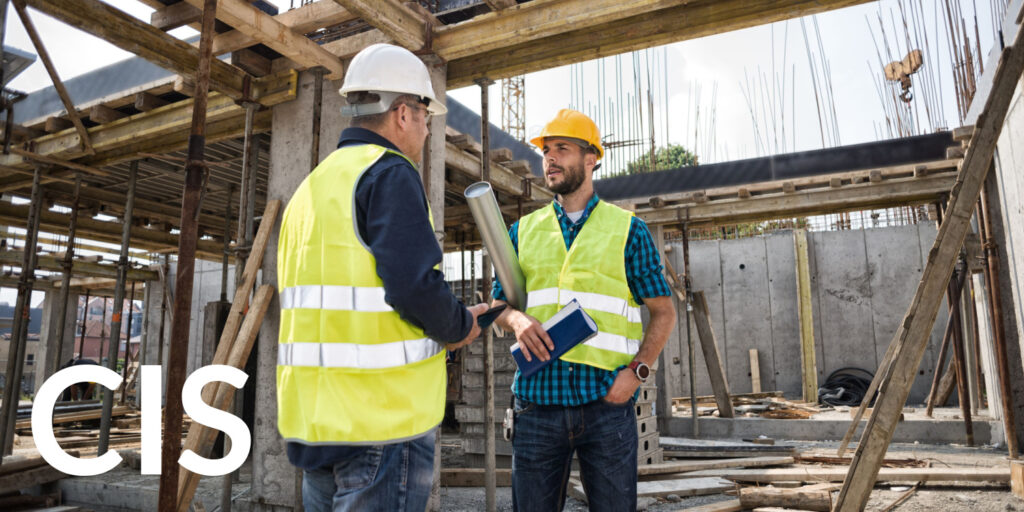If your company pays subcontractors to carry out construction work, you will need to register it as a contractor under the Construction Industry Scheme (CIS). You will use this HMRC scheme to deduct a percentage of tax from the payments you make to self-employed subcontractors.
However, if you are a subcontractor performing work for contractors, you can choose whether or not to register for the Construction Industry Scheme. Your decision will affect how much contractors can deduct from your payments.
Let’s take a look at this topic in detail, including the types of work covered by the Construction Industry Scheme, how to register your company as a contractor or subcontractor under CIS, and why deductions are made to payments.
What is the Construction Industry Scheme?
The Construction Industry Scheme (CIS) is a UK tax-deduction scheme administered by HMRC. It requires contractors to deduct tax from payments they make to subcontractors, excluding VAT and the cost of materials the subcontractor incurs.
Contractors then pass on these deductions to HMRC as ‘advance payments’ toward the subcontractor’s Self Assessment or Corporation Tax bill.
The amount of tax that a contractor deducts depends on whether the subcontractor chooses to register themselves as such under CIS and whether they apply for ‘gross payment status’. We discuss this in more detail later.
CIS only applies to subcontractors who work for a contractor in a ‘self-employed’ capacity under the terms of a particular contract. It does not apply to workers who perform tasks for a contractor under a contract of employment and/or those who are paid through Pay As You Earn (PAYE).
Types of construction work covered by CIS
The Construction Industry Scheme covers all types of construction operations, including:
- site preparation
- alterations
- repairs
- refurbishment
- decorating
- dismantling
- demolition
- construction
- any other type of construction work that is done to a permanent or temporary building or structure, or to a civil engineering work or installation
The scheme only applies to construction work carried out within the UK, including UK territorial waters up to the 12-mile limit. It does not cover any construction work outside the UK.
Work not covered by CIS
Certain types of jobs are exempt from the Construction Industry Scheme, including:
- architecture and surveying
- scaffolding hire (with no labour)
- carpet fitting
- delivering materials
- activities on construction sites that are not construction-related (e.g. running a canteen or providing site facilities or security services)
Additionally, contractors are exempt from CIS if their work is:
- paid for by a trust or charity
- paid for by a governing body or head teacher of a maintained school on behalf of a local education authority
- carried out on the subcontractor’s own property and is worth less than £1,000, excluding materials
CIS also does not apply to deemed contractors who are paying for:
- work on property (that isn’t for sale or rent) for their own business use
- a construction contract that is worth less than £1,000, excluding materials
More information on the types of work covered by the scheme is available in HMRC’s CIS guide for contractors and subcontractors.
Who needs to register for the Construction Industry Scheme?
You are legally required to register as a contractor under the Construction Industry Scheme if you are either of the following:
- a mainstream contractor – your principal business activity is construction and you pay subcontractors to carry out construction work
- a deemed contractor – your company does not do construction work, but you have spent more than £3 million on construction operations in 12 months.
Mainstream contractors include builders and other construction businesses, property developers, labour agencies, and gangmasters/gang leaders.
Deemed contractors often include housing associations, arms’ length management organisations (ALMOs), public bodies, and large organisations such as banks, supermarkets, utility companies, and property investors.
The legal structure of these businesses has no impact on whether or not they need to register. CIS applies to all types of legal business structures working in the construction industry, including:
- limited companies
- unlimited companies
- limited partnership and limited liability partnerships (LLPs)
- general partnerships
- sole traders
These businesses may be contractors, subcontractors, or both.
If you are a self-employed subcontractor, you can choose whether or not to register for the Construction Industry Scheme as a subcontractor. From a tax perspective, it is beneficial to do so.
What is a contractor?
In construction, a contractor is a business or other type of enterprise that is hired by a property owner to oversee and complete a building project. In turn, the contractor may hire subcontractors to carry out specialised parts of the project.
Contractors can be building firms, construction companies, housing associations, government departments, local authorities, or any other type of organisation.
Additionally, any business or other type of enterprise that has spent more than £3 million on construction work in a 12-month period will be classed as a contractor for the purposes of the Construction Industry Scheme.
What is a subcontractor?
A subcontractor is a business that undertakes construction work for a contractor in charge of a project. They could be plumbers, electricians, plasterers, painters and decorators, roofers, or any other type of specialist construction trade.
Subcontractors are hired by a contractor, rather than the property owner who is commissioning the work. This means that subcontractors are paid directly by the contractor, and these payments should usually be made under the Construction Industry Scheme.
How to register for the Construction Industry Scheme
How you register for the Construction Industry Scheme depends on whether you are a contractor or a subcontractor. We explain both registration processes below.
Register as a contractor
To register as a contractor for CIS, you must follow the process for registering as an employer and setting up PAYE. You can complete both of these tasks at the same time.
If you operate as a limited company with 1 to 9 directors, you can register as a contractor online. Otherwise, you must register by phone.
The first step is to answer the following questions to confirm to HMRC that you are eligible to register online:
- Does at least one company director have a UK National Insurance number?
- Is the company an offshore employer outside the European Economic Area (EEA) that does not pay UK National Insurance?
- Over the next two months, will the company pay out any non-cash incentive awards?
If you are eligible, click ‘Continue’ and sign in to (or create) your Government Gateway account. You will then be prompted to complete the following steps online:
- Tell HMRC which tax you want to register for – select ‘PAYE for Employers’
- Specify the type of business you want to register for CIS – select ‘Limited company’
- Provide your Company Unique Taxpayer Reference (UTR)
- Enter the date of the first payday or the first date you made payments of expenses or provided benefits to your employees
The final step is to provide the following details about your business:
- Company name
- Trading name (if different)
- Nature of the business (the type of work your company does)
- Registered office address and business address (if different)
- Business telephone number and email address
- Company registration number
- Number of employees (if any) you employ, or expect to employ, in this year
- Answer ‘Yes’ to the question “Will you be engaging any subcontractors in the construction industry this year?”
- Contact name, telephone number, and email address for PAYE correspondence
- Name and National Insurance number of each company director
Within approximately 10 days after registration, HMRC will send you a letter with your employer’s PAYE reference and Accounts Office reference. You will need both of these to operate PAYE and complete CIS payment tasks.
Already registered as an employer?
If you are already registered as an employer, there is no need to complete the process a second time to register for CIS. You simply need to call the CIS Helpline and request that your existing PAYE scheme is updated to include the Construction Industry Scheme.
You will be required to answer some questions and provide certain information about your business, including your PAYE and Accounts Office references and your company UTR.
Register as a subcontractor
To register your company as a subcontractor under CIS and have payments from contractors paid to your company in full, your business must satisfy all of the following conditions:
- Carries out construction work (or provides labour for it) in the UK
- Operates through a bank account
- Has a net construction turnover of £30,000 each year for each relevant person (i.e. each company director or self-employed partner) or at least £100,000 for the entire business
- Has complied with all tax obligations in the past
These conditions are known as the business, turnover, and compliance tests.
If you are eligible to register, you will need to provide the following details:
- Full company name
- Trading name (if different)
- Registered office address
- Trading address (if different)
- Company Unique Taxpayer Reference (UTR)
- Company registration number
- The date on which the company started or plans to start working in the UK construction industry
- Type of construction work the company does
- VAT registration number (if applicable)
- Verification number(s) provided by any contractors who have paid you as a subcontractor in the construction industry since 6 April 2007
Next, you must specify how you want to get paid as a subcontractor. You can choose to receive ‘payment under deduction’ or ‘gross payment’ from contractors.
If you select payment under deduction, contractors will make deductions from payments to your company at the standard CIS deduction rate, which is 20%.
Contractors will only make deductions at the higher rate of 30% if:
- you are not registered for CIS
- they are unable to verify you as a subcontractor
- you provide the wrong name for your business
Any deductions made will be paid to HMRC as ‘advance payments’ and credited against your company’s Corporation Tax liability at the end of the year (or Self Assessment liability if you’re a sole trader or self-employed partner).
If you select gross payment, contractors will not make any deductions from your payments. Instead, they will pay you in full and you will pay all of your Corporation Tax at the end of the tax year.
Making CIS deductions and paying subcontractors
If you pay subcontractors, you will most likely need to make deductions to their payments, which you will then pass on to HMRC.
HMRC will tell you how much you need to deduct from a subcontractor’s payments when you verify them.
The deduction rates for payments made under the Construction Industry Scheme are:
- 20% for registered and verified subcontractors
- 30% for unregistered or unverified subcontractors
- 0% for subcontractors with ‘gross payment’ status
You will normally pay subcontractors directly after you make any necessary deductions. Each time you pay them, you must provide them with a payment and deduction statement within 14 days of the end of the tax month.
To make a deduction from a subcontractor’s payment, you should start with the gross (total) amount stated on their invoice, excluding any VAT they have charged.
Next, you will subtract the cost of materials incurred by the subcontractor, including:
- equipment that is now unusable
- fuel used, except for travelling
- equipment hired specifically for the job
- manufacturing costs or prefabricated materials
- materials purchased by the subcontractor to fulfil the contract
After deducting the qualifying materials from the gross amount, you will deduct the CIS percentage rate provided by HMRC. The figure you are left with is the amount that you will pay the subcontractor.
Example:
You receive the following invoice from a subcontractor:
- Labour £10,000 + VAT £2,000
- Materials £1,000 + VAT £200
- Invoice total £11,000 + VAT £2,200
The gross amount that you start with is £11,000. This is the total amount of the invoice, excluding VAT of £2,200.
Subtract the cost of qualifying materials (excluding VAT), which is £1,000. This leaves an amount of £10,000.
Apply the 20% CIS deduction rate to the £10,000. This results in a deduction of £2,000, leaving a net amount of £8,000.
Pay the subcontractor £11,200 (£8,000, plus £1,000 for qualifying materials and £2,200 VAT).
Send the £2,000 CIS deduction to HMRC as advance payment toward the subcontractor’s Corporation Tax or Self Assessment bill.
Verify subcontractors
Before paying any new subcontractors, you must ‘verify’ them with HMRC to determine:
- whether they are registered for the Construction Industry Scheme
- what CIS deduction rate you need to apply to their payments
You will also need to verify subcontractors you have used before if you’ve not included them on any CIS monthly returns in the current or previous tax year.
To verify a subcontractor, you will need to provide your company’s:
- Unique Taxpayer Reference
- Accounts Office reference
- Employer PAYE reference
You will also need to provide the following information about the subcontractor:
- Unique Taxpayer Reference
- National Insurance number (if they are a sole trader)
- Company name, company UTR, and registration number (if they are a limited company)
- nominated partner details, trading name, and partnership UTR (if they are a partnership)
Once HMRC verifies the subcontractor, they will send you a verification reference number for your records. It will begin with V and be followed by 10 numbers (e.g. V1231231234).
Filing CIS monthly returns and keeping records
When you register as a contractor, you must send CIS monthly returns to HMRC to report the payments you make to subcontractors.
You can file these electronically using HMRC’s Construction Industry Scheme online service. The deadline is 14 days after the end of each tax month.
You will also need to keep certain records, including:
- the gross amount of subcontractors’ payments, excluding VAT
- any deductions you make to subcontractors’ payments
- the qualifying materials on subcontractors’ invoices, excluding VAT.
These records must be kept for a minimum period of three years after the end of the tax year to which they relate.
Wrapping up
We hope this post has left you with a clearer understanding of the Construction Industry Scheme, including the type of work it covers, how to register your company as a contractor or subcontractor, and why deductions are made to subcontractors’ payments.
If you are at all unsure of your position about CIS or need help with the registration process, we would advise contacting the CIS Helpline or speaking to your accountant.
If you have any questions about this post or any aspect of setting up and running a limited company, please leave a comment below or contact our company formation specialists for advice.
Please note that the information provided in this article is for general informational purposes only and does not constitute legal, tax, or professional advice. While our aim is that the content is accurate and up to date, it should not be relied upon as a substitute for tailored advice from qualified professionals. We strongly recommend that you seek independent legal and tax advice specific to your circumstances before acting on any information contained in this article. We accept no responsibility or liability for any loss or damage that may result from your reliance on the information provided in this article. Use of the information contained in this article is entirely at your own risk.


















Join The Discussion